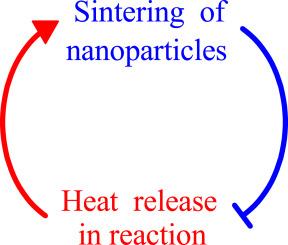Sintering of catalytic metal nanoparticles under exothermic conditions in a continuous stirred tank reactor
IF 3.9
3区 工程技术
Q2 ENGINEERING, CHEMICAL
引用次数: 0
Abstract
Academic studies of sintering of supported metal nanoparticles usually imply that the system temperature is constant and the growth of the average nanoparticle radius and decrease of dispersion or activity can be described by the power-law equations. In catalytic applications, the sintering typically occurs in reactors under exothermic conditions at high temperatures, and the sintering-related loss of the catalyst activity may result in decrease of temperature, which in turn may reduce the rate of sintering. Focusing on catalytic conversion in a continuous stirred tank reactor, I show that in the presence of this negative feedback the power-law equations can be used as well by introducing the apparent exponent which is appreciably larger than that measured or predicted by the conventional models of sintering at constant temperature.

连续搅拌槽反应器中放热条件下催化金属纳米颗粒的烧结
学术上对负载型金属纳米颗粒烧结的研究通常意味着系统温度是恒定的,纳米颗粒平均半径的增长和分散性或活度的降低可以用幂律方程来描述。在催化应用中,烧结通常发生在高温放热条件下的反应器中,与烧结相关的催化剂活性损失可能导致温度降低,从而降低烧结速率。聚焦于连续搅拌槽反应器中的催化转化,我表明,在这种负反馈的存在下,幂律方程也可以通过引入表观指数来使用,表观指数明显大于传统的恒温烧结模型所测量或预测的指数。
本文章由计算机程序翻译,如有差异,请以英文原文为准。
求助全文
约1分钟内获得全文
求助全文
来源期刊

Chemical Engineering Research & Design
工程技术-工程:化工
CiteScore
6.10
自引率
7.70%
发文量
623
审稿时长
42 days
期刊介绍:
ChERD aims to be the principal international journal for publication of high quality, original papers in chemical engineering.
Papers showing how research results can be used in chemical engineering design, and accounts of experimental or theoretical research work bringing new perspectives to established principles, highlighting unsolved problems or indicating directions for future research, are particularly welcome. Contributions that deal with new developments in plant or processes and that can be given quantitative expression are encouraged. The journal is especially interested in papers that extend the boundaries of traditional chemical engineering.
 求助内容:
求助内容: 应助结果提醒方式:
应助结果提醒方式:


